[ad_1]
While the planet has only eight species of bears, there is a lot of diversity within those species. The commonly known brown bear can be found in North America, Asia, and Europe. One of the largest subspecies of brown bears can be found on an island off Alaska’s southern coast: the Kodiak bear.
I lived on Kodiak for several years of my life, and I was able to see the immensity of the Kodiak bear on more than one occasion. Luckily, I never had a dangerous “close encounter” with the enormous bear, but they are impressive from just about any distance.
In this article, I will explain what a Kodiak bear is, where it lives, describe its characteristics, compare the Kodiak bear with other types of bears, provide information on how to encounter one, and provide guidance on what to do if you’re ever faced with a Kodiak bear attack.
Let’s get started!

What is the Kodiak Bear?
Kodiak bear (Ursus arctos middendorffi) is a brown bear subspecies that can be found on the Kodiak archipelago in Alaska. Kodiaks are sometimes called grizzlies as they share some physical characteristics with a grizzly, but they are not actually part of the grizzly family. Scientists think Kodiaks have been reproductively removed from grizzlies for more than 12,000 years. (source: FWS.gov)
A fully grown Kodiak bear can weigh up to 1,600 pounds or 720 kg, making it one of the world’s largest carnivores. A male Kodiak bear can reach a height of 10 feet when standing on its back legs. While the female bears are also quite large, they are about 20% smaller than their male counterparts.
Kodiak Bear characteristics:
- Habitat: Kodiak archipelago in Alaska
- Average weight: Adult males are 600 to 1,400 lbs (272 to 635 kg) – Adult females are 300 to 700 lbs (136 to 318 kg)
- Average standing height: 9 to 10 feet
- Average height on four: 5 feet
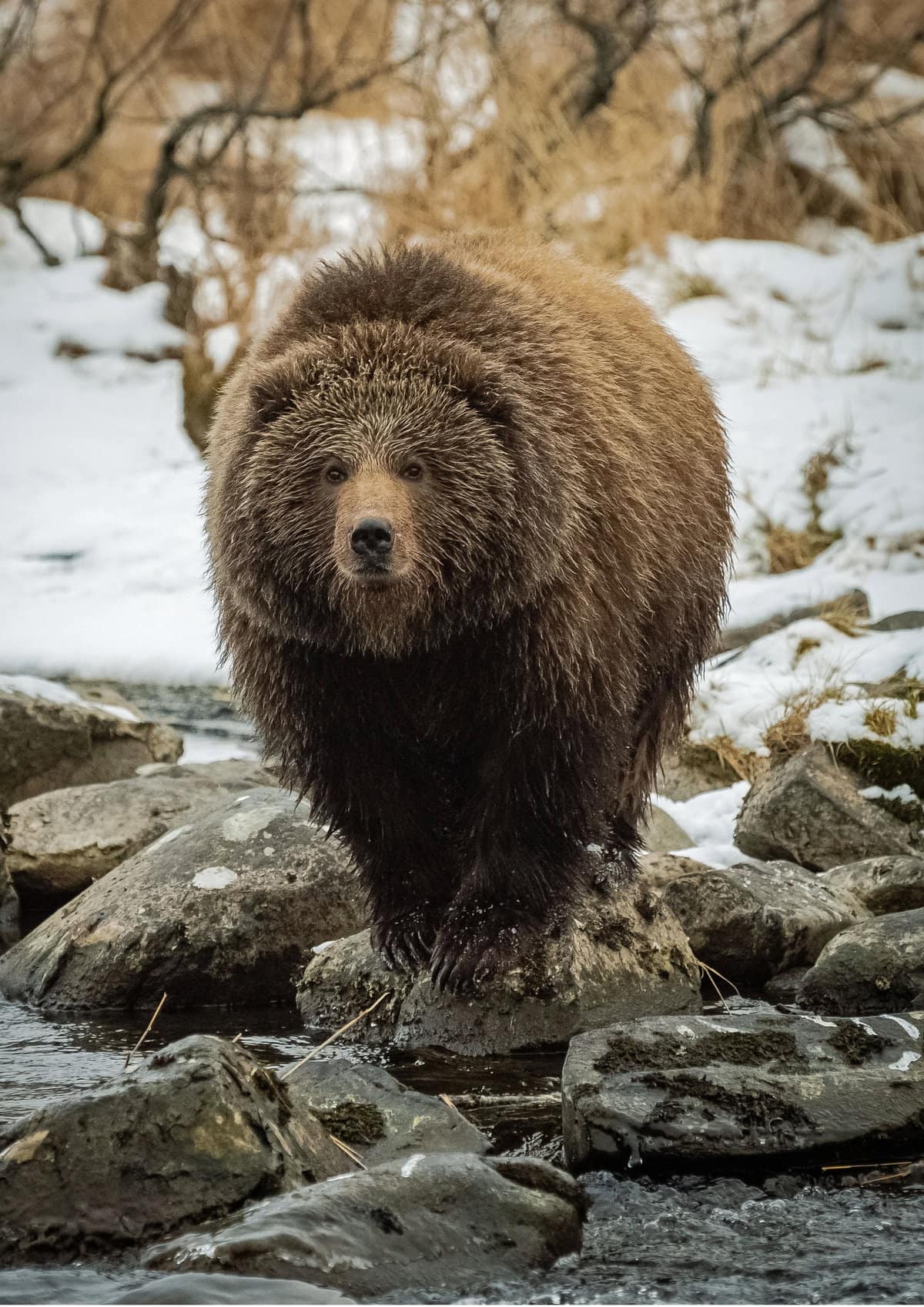

Males are called boars, and female bears are called sows. Baby Kodiak bears are referred to as cubs. Their hair is generally a brown hue, but it can vary from light to orangy to dark brown. Cubs are born with a “natal ring” of white fur around their necks that fades after a couple of years.
Where Does the Kodiak Bear Live?
Kodiak brown bears only live in the Kodiak Archipelago in Alaska. They are found across the 5,000 sq mi (13,000 km2) Kodiak archipelago, which includes the islands of Kodiak, Afognak, Raspberry, Shuyak, Sitkalidak, Uganik, and a few smaller islands adjacent to the ones listed. The bears rely on abundant local resources, allowing them to maintain small home ranges, unusual for bears of this size.
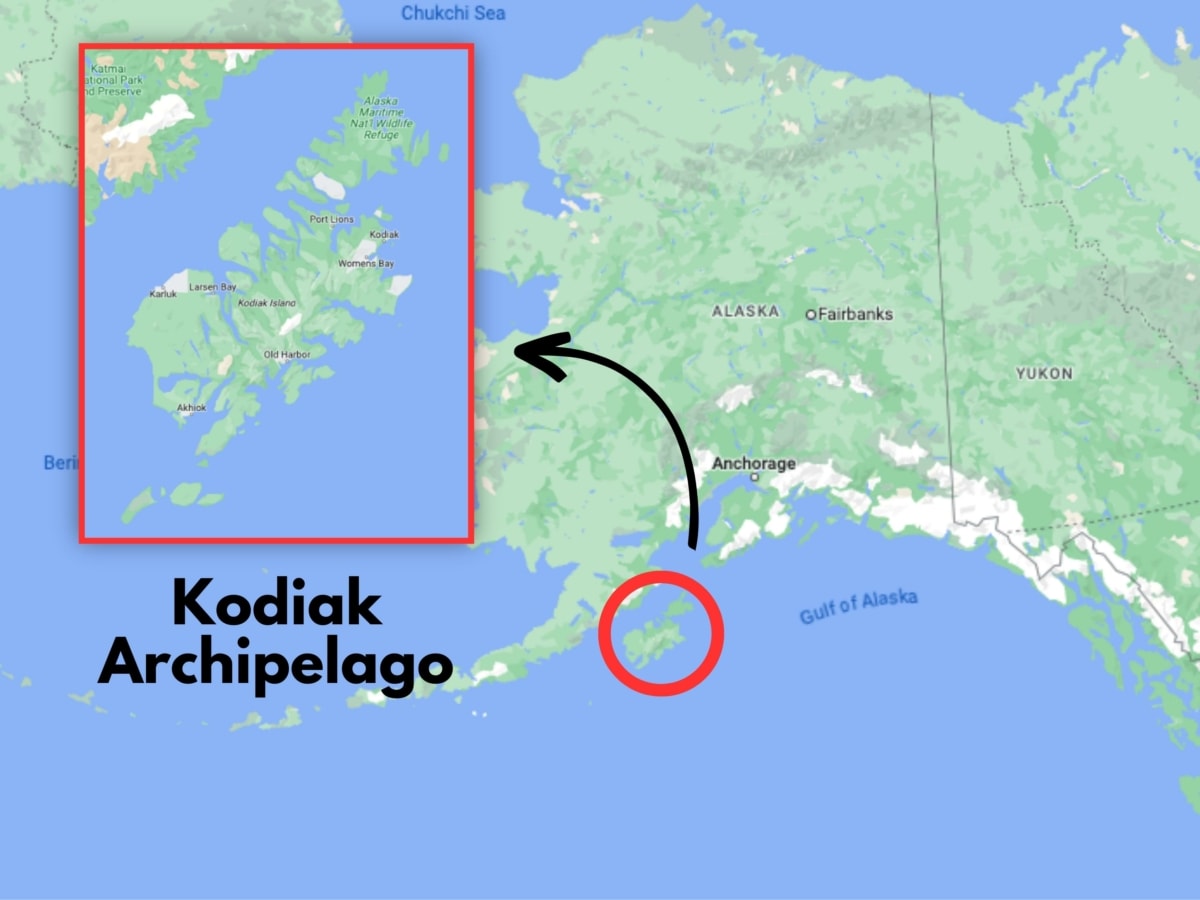

Adult boars maintain home ranges that average about 97 sq mi (250 km2), and sows have slightly smaller home ranges of 50 sq mi (130 km2). Kodiak bears don’t defend their territories, as food is often abundant.
The Kodiak Archipelago is in a subpolar oceanic climate zone meaning the temperatures are cool and skies are often overcast. Heavy precipitation can be expected for most of the year, accompanied by fog and wind. The vegetation and topography of the archipelago range from dense forests to snow-capped mountains. Sitka spruce is in abundance, and a large swath of the land belongs to the Kodiak National Wildlife Refuge.
The islands are home to roughly 14,000 people, with the bulk of them living in or near Kodiak city. There are also six populated villages in the archipelago. However, roads and other signs of human infrastructure are pretty much limited to Kodiak Island and Afognak Island.
How Many Kodiak Bears Are Left?
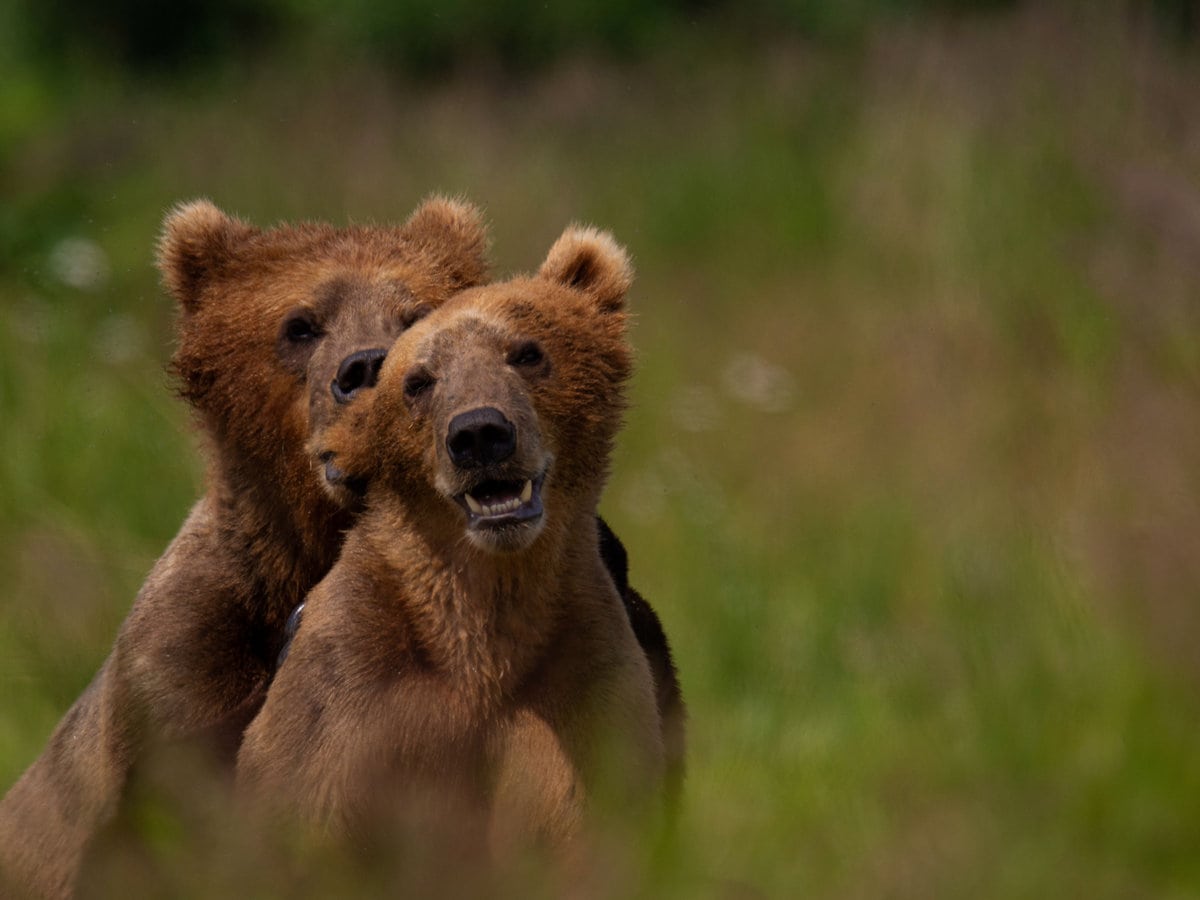

Kodiak bears are not an endangered species. There are an estimated 0.7 bears per square mile in the archipelago — about 3,500 bears in total. Due to the managed population of fish and the refuge status of a lot of the Kodiak bears’ habitat, the population is stable.
In the 1800 and 1900s, there was a concern for the Kodiak bear population as European explorers heavily hunted the bears as a novelty. However, the Kodiak National Wildlife Refuge was established in the 1940s to protect the bears and allow them to return to sustainable levels. While hunting Kodiak bears is legal now, it is heavily regulated and monitored by the Alaska Department of Fish and Game.
The biggest threat to Kodiak bears currently is climate change. The warming climate in Alaska is changing salmon patterns and when berries ripen — two main food sources for the bears.
What is the Largest Bear Species in the World?
While the Kodiak bear is quite large, the polar bear is actually the largest species — the great Kodiak comes in at a close second, though!
Most experts agree the polar bear takes the top spot, but some outliers consider the Kodiak to be larger. The confusion comes from the vagueness of the word “largest.” For some, largest means heaviest. For others, it could mean length. And then there is the discussion over whether “largest” refers to the average of the species or the largest single bear ever recorded.
Kodiak Bear Size Comparison
| Bear | avg height on four | avg height standing | avg weight |
| Polar bear | 3.5 to 5 ft | 10+ ft | 770 to 1,540 lb |
| Kodiak bear | 5 ft | 10 ft | 600 to 1400 lbs |
| American black bear | 3 ft | 5 to 7 ft | 130 to 660 lbs |
| Giant panda | 2 to 3 ft | 4.8 to 6 ft | 150 to 280 lbs |
| Grizzly bear | 3.6 to 4.6 ft | 8 to 9.9 ft | 400 to 800 lbs |
| Sloth bear | 2 to 3 ft | 5.3 to 6 ft | 200 to 300 lbs |
| Asian black bear | 2.10 to 3.4 ft | 5 to 5.6 ft | 200 to 400 lbs |


The Largest Kodiak Bear Ever Recorded
Kodiak bears are the size kings of the brown bear subspecies. Hunters have recorded 16 of the largest brown bear kills in the Kodiak Archipelago.
Kodiaks can get even larger when in captivity! The largest (known) Kodiak was 2130 pounds at his death in 1987. His name was Clyde, and he was a resident of the Dakota Zoo in North Dakota, where he lived until the age of 22. The zoo director recorded Clyde’s fat layer at 9 inches upon his death!
What Does the Kodiak Bear Eat?
While most people think of Kodiak bears as meat eaters — they are often called the largest carnivore on land — they are actually omnivores. The Kodiak’s diet consists of more grass, berries, and plants than meat. Fish is a huge part of the Kodiak bear’s diet, however. Because the habitat in the archipelago is so abundant, Kodiak bears rarely make an effort to chase down a mammal for a meal.
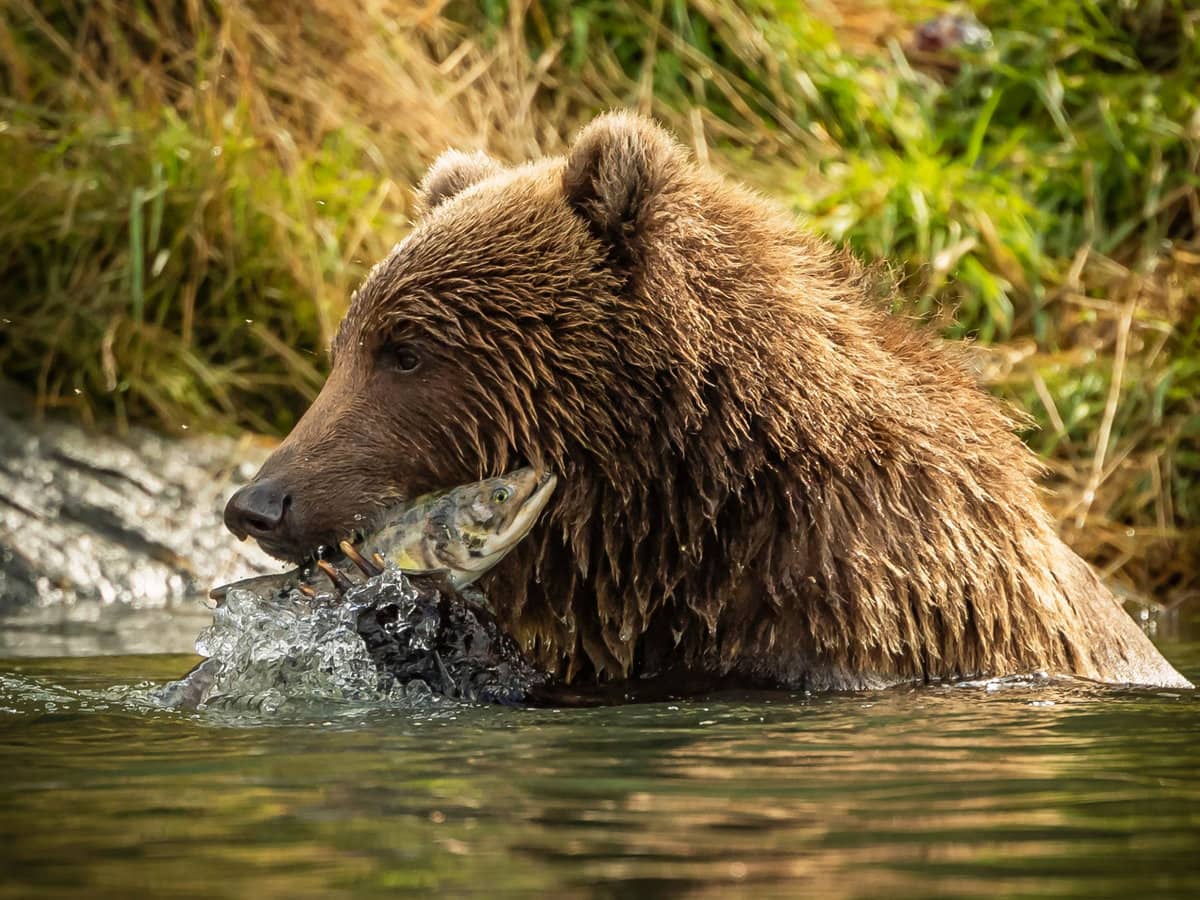

Kodiak bears are intelligent eaters. They focus on the most nutritious portions to maximize weight and minimize effort. They eat grasses when they are abundant in the spring and summer and focus on berries when they are ripe. When eating salmon, the bears focus on the flesh and eggs. If they consume deer or elk, they first go for the internal organs.
As diurnal animals, Kodiak bears are typically active during daylight hours. However, they will adopt nocturnal tendencies in more crowded areas or when there is a food shortage.
Do Kodiak Bears Hunt Humans?
Kodiak bears do not hunt humans. The Alaska Department of Fish and Game states that the last 75 years have only seen one person killed by a Kodiak. Although, the bears do injure people about once per year.
How Fast Can a Kodiak Bear Run?
According to the National Wildlife Federation, a Kodiak bear can reach a speed of 35 miles per hour over short distances (source). Considering that the average human speed is approximately 15 mph, you cannot outrun a determined Kodiak bear at its top speed.
What Do You Do if a Kodiak Bear Approaches You?
While, of course, you hope it doesn’t, encounters with Kodiak bears do happen. A bear may approach you in two ways: an aggressive charge, or a bluff charge.
👉 Of the two, the bluff charge is more common as it is meant to intimidate and scare you away. If the bear is bluffing, the head will be up and forward, and the bear will “puff up” to make itself look bigger. The charge will be towards you in big leaps, but the bear will stop short or veer to one side. The bear will likely vocalize its displeasure quite loudly.
Do not run from a bluff charge, as it could trigger an attack. Instead, stand your ground, speak in a calm voice, and after the initial charge, back away slowly. The goal is to let the bear know you are human and not a threat.
👉 Should the bear turn aggressive, its posture will change to a head and ears down position. It may clack its teeth together and pound the ground with its front paws. These are stress indicators, and a stressed bear may charge.
When a brown bear (Kodiaks are subspecies of brown bears) charges, you will want to play dead. Fighting back will make the bear even more aggressive. Your arms can be used to protect your head and your neck, and let your pack protect your back while you lay on your stomach. Stay as quiet as possible so the bear doesn’t think you are a threat to itself or its cubs.
If the bear persists in its attack, you may need to fight back in order to survive. Aim your punches and kicks at the nose and the eyes, and use any weapons at your disposal — rocks or branches. If you have bear spray, use it liberally!
That’s why I always advise my friends who come to visit Alaska: If they plan to go on a hike here, I tell them to always, and I mean ALWAYS, have bear spray with them and keep it in a front pocket that is easily accessible for use when needed.
👉 Here’s a top-rated one you can buy from Amazon: Counter Assault – Distant Bear Repellent Spray.
Watch this video for more details on what to do if you encounter a bear.
Kodiak Bears Viewing
Catching a glimpse of a Kodiak bear is a bucket list item for many Alaskan visitors, and there is no better place to find them than Kodiak Island! It is possible to see a bear wandering around while you are out salmon fishing or on your hotel grounds. Bears have been spotted around the Buskin River lodgings!
Intentional bear viewing can be done in two ways: on the road system or off the road system. There are roughly 50 miles of paved roads on Kodiak’s northeastern side. Off-road options include ATV excursions, boat trips, and float planes. I took a float plane tour when I lived on Kodiak, and we saw a mama bear and her two cubs!
The best time to go bear spotting in Alaska is in July, August, and September. It is always advised that you hire a local guide for your safety and a better chance of seeing a great Kodiak.
You can also book a stay at one of the remote wilderness lodges where you may be able to see a bear from your room accommodations! One such lodge is the Kodiak Brown Bear Center & Lodge in the Kodiak National Wildlife Refuge. It is owned by the Alutiiq people and offers hiking, kayaking, fishing, and bear viewing.
There are a few Kodiak bears in zoos around the U.S. For instance, twins Munsey and Boda call the Wildwood Park & Zoo in Wisconsin home. The pair were rescued by a hunter as cubs after their mother was killed.
Conclusion
Kodiak bears are magnificent creatures — some of the largest bears on the Earth! They are one of the highlights to many people’s Alaskan adventures.
If you plan your trip to the Kodiak archipelago in the late summer months, you will have a good chance of seeing one of these unique bears with your own eyes.
Practice bear safety, hire a guide, and set out on your own bear adventure.
While the bear populations in Kodiak are doing well currently, they are in danger of losing their natural habitat due to human encroachment and warming climates. When visiting Alaska, be sure to be a good steward of the land, and continue your conservation efforts while at home as well! We can all do our part to protect the planet’s wonderful biodiversity.
For more Alaskan wildlife here are 25 animals in Alaska to see on your next adventure.
How do you feel about this article?
[ad_2]
Source link
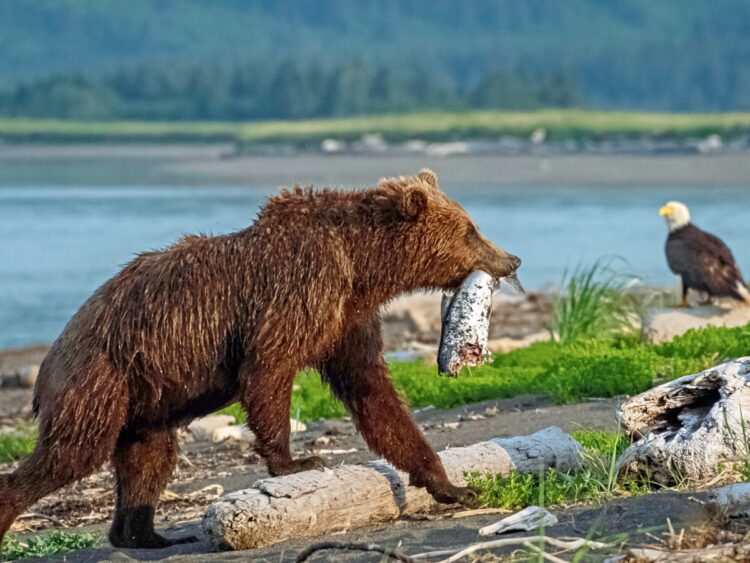


No Comments
Leave Comment